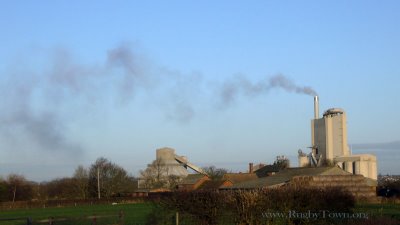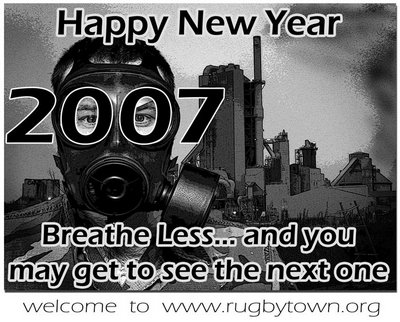 AND THE WAR RAGES ON IN RUGBY
AND THE WAR RAGES ON IN RUGBYMERRY GO ROUND SPINS OUT OF CONTROL AS COURT CASES ESCALATE! WHO IS BEATING WHO?

SO...
RIP VERSUS THE EA; DEFRA; TREASURY; CEMEX; RBC; WCC
We have Rugby in Plume/Rugby residents in the GREEN corner taking on the Environment Agency (sludge corner) for unlawfully issuing an IPPC Permit. RIP request the House of Lords to QUASH the UNLAWFUL IPPC PERMIT: but the EA are backed up by, and joined by the very INTERESTED PARTIES, of DEFRA and the TREASURY (RED Blairite) ; and by Cemex (ORANGE Rugby Cement) - who work with RBC (YELLOW for obvious reasons), and with WCC (BLUE) (trying to stay in the background) : which all COLLUDE to try to "get away with it" and to PULP Rugby residents.
AND.....
Then the Agency scores against Cemex: a stunning £400,000 fine for polluting Rugby during tyre trials - see Warwick Crown Court 3rd October 2005. But Cemex, perhaps thinking that their "apology" to Rugby residents was enough of a penalty, now say they find the fine "disproportionate" and attempt to reduce it in an Appeal at the High Court.
IN COLORADO....
Cemex incurred a $1,500,000 penalty for pollution in a court action December 2006.
IN THE MEANTIME...
CEMEX TAKES ON DEFRA AND THE EU:
Rugby Advertiser (11/01/07) Reports:
Rugby Cement Cemex has lost a unique High Court challenge to scrap the limit of carbon Dioxide it can emit. In what was regarded as a test case Cemex asked top Judge Mr Justice Sullivan to quash the Government decision to allocate a CO2 emission cap on its works. It also sought an order to top DEFRA from re-allocating 343,838 tonnes of emissions from Rugby to another competitor.
BUT THE HIGH COURT REJECTED... the challenges, and said the rulings had NOT infringed "equality and discrimination" laws, as argued by Cemex. The CO2 cap was put on by DEFRA who said the Rugby plant could not emit more than 819,974 tonnes of carbon dioxide. Cemex also put forward an order in front of the High Court to stop DEFRA from re-allocating more than 343,838 tonnes of CO2 to one of its competitors. BUT Mr Justice Sullivan said DEFRA was justified in its decisions.
CEMEX HAD ARGUED...
That the allocation breached the EC principles of equality and discrimination, and " constitutes an unjustified interference with the fundamental right of freedom of establishment enshrined in Article 43 of the EC TREATY".
It also claimed that the ruling infringed Article 87, "prohibiting competitive distortions caused by unjustified State Aid." The Rugby Cement owners had already out forward the same arguments before the EC last November, but ended up with the same unsuccessful outcome when the EU Commission backed the UK's national Allocation plan for emissions.
WHAT THE PUBLIC SAY:
ADVERTISER POSTBAG:
I HOPE MRS P. STAYS A THORN IN THEIR SIDES...
I found the letter, "There is another side to the company" very interesting, inasmuch as the writer failed to tell us just what position he held at the Rugby Cement company prior to his retirement in such illuminating circumstances. Would he, for instance, have been granted the use of a car to use 'carte blanche' if his job was to 'sweep the yard'? I suspect not!
I can assure the writer of the glowing vision of the generosity of Rugby Cement, that the owners of the mills in Bradford and elsewhere, producing ASBESTOS, treated their employees in very much the same manner: including day trips to Blackpool, and Christmas and New Years Parties.
Their attitude, however, was entirely different when the workers began looking for compensation for ASBESTOSIS! Lilian P. is trying to get the Council to ENSURE that Rugby Cement does not treat the people of Rugby in the same manner that the asbestos companies treated their workers, and the SURROUNDING POPULATION!
I sincerely hope Lilian will remain a thorn in the sides of all concerned until they: TOE THE LINE! and COME CLEAN!
R. M. Knight,
Constable Road,
Rugby.
I AM CONCERNED AT WAY CEMEX PORTRAYS ITSELF...
I would like to voice my concern over a recent publication by Cemex owners of Rugby Cement entitled "COMMUNITY MATTERS" dated December 2006. My concern is that a large company like Cemex, with all its financial backing, can be SO ECONOMICAL WITH THE TRUTH: i.e. their portrayal of the VISUAL EFFECTS on the Community! (Which you can plainly see from the enclosed photographs it is easy to prove - using even the minute resources of a retired member of the public.)
My major concern is that it will be far simpler for Cemex, with all its infinite resources, to hide technical facts that Joe Public cannot disprove. I don't need to point out that whatever comes out of the cement works chimney - if you can see it - it can reach you and your families!
Cemex have shown little remorse so far fo the health hazards caused to date, and the DANGLED CARROT of the so-called 'nature reserve' in the very distant future does not fill me with JOY! Newbold Quarry Nature Reserve springs to mind - and how many lives has that claimed?
It is high time the people of Rugby SPOKE OUT about the UGLY MONSTER in our midst. It is were a wind turbine I'm sure it would get far more response?
T. Enticott,
Wordworth Road.,
Rugby.



